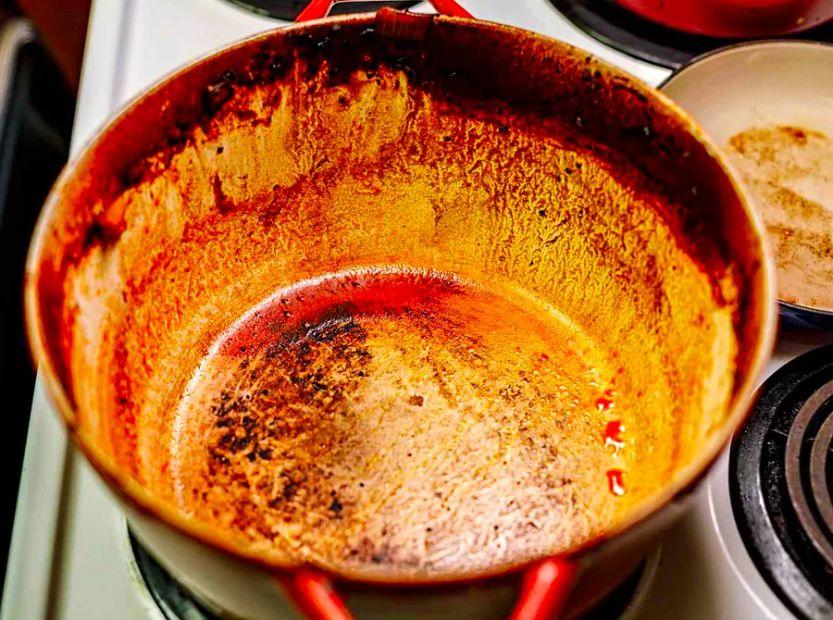How to Clean a Dutch Oven — Cast Iron vs. Enameled Cast Iron

A quality Dutch oven is a staple in any well-stocked kitchen or wedding registry. These versatile pots boast deep interiors perfect for cooking large cuts of meat and hefty quantities of liquids. Their thick walls ensure excellent heat retention, making them a must-have for slow cooking.
No fall or winter kitchen is complete without a Dutch oven. Whether you're cooking stews, curries, chilis, or braising meat, it’s the go-to pot for hearty dishes. A premium Dutch oven can set you back a few hundred dollars, but with the right care, it will serve you for decades. Learn how to clean and maintain yours in a few simple steps.

Cast Iron vs. Enameled Cast Iron
There are two main types of Dutch ovens you should know: cast iron and enameled cast iron. While both are made from cast iron, enameled cast iron features a hard, non-stick enamel coating. These are easier to clean, don’t require seasoning, and come in a variety of colors compared to their plain cast iron counterparts.
On the other hand, cast iron Dutch ovens are typically more durable and less expensive. Ultimately, the choice between the two comes down to personal preference. We’ll guide you on how to clean both types.
Important: If you're using a new cast iron Dutch oven, you must season it before use.
To season your cast iron Dutch oven, coat both the inside and outside with cooking oil, then bake it at 350°F for 30 minutes. After that, apply another layer of oil, reduce the temperature to 200°F, and bake for another hour. Once finished, leave it in the oven overnight, then apply a final layer of oil the next morning.
Your cast iron Dutch oven should develop a smooth, glassy black finish once it’s properly seasoned. After seasoning and using your Dutch oven, it’s important to know the proper cleaning method.

How to Clean a Cast Iron Dutch Oven
Here’s What You’ll Need:
- Cooking oil
- Paper towels
- Water
- Brush scrubber
- Chainmail scrubber (optional)
- Wipe down your Dutch oven: Cast iron Dutch ovens need regular care. After every use, wipe it down with a dry paper towel. For stubborn residue, a damp towel can help, but make sure to dry it thoroughly afterward.
- Bring water to a boil: Fill the Dutch oven with water, covering any burnt food bits. Bring it to a boil, then remove from heat to let the water loosen the residue.
- Scrub the interior: Once the water cools, scrub away the residue with a brush or a chainmail sponge for tough spots. Dish soap is fine, but be prepared to touch up the seasoning afterward. Rinse the Dutch oven when you're done.
- Dry your Dutch oven: Dry the Dutch oven with paper towels. For extra assurance, you can heat it over medium heat on the stove for 20 minutes.
- Apply a fresh coat of oil: Pour a little cooking oil into the Dutch oven and rub it in with a paper towel. Wipe away any excess oil with a clean towel.
How to Clean an Enameled Cast Iron Dutch Oven
Here’s What You’ll Need:
- Hot water
- Dish soap
- 2 tbsp baking soda
- Dish scrubber
- Dish towel or drying rack
While enameled cast iron Dutch ovens don't require seasoning, you need to handle them carefully during cleaning to avoid damaging the enamel. Some enameled Dutch ovens are dishwasher-safe, but to extend their lifespan, we recommend hand washing them.

- Soak your Dutch oven: After using your Dutch oven, allow it to cool, and fill it with hot water, dish soap, and two tablespoons of baking soda. Cover, and let it sit for about 15 minutes.
- Scrape and scrub: Pour out the water and use a dish scrubber or sponge (just not steel wool), hot water, and dish soap to remove any residue.
- Use this paste for stubborn stains: If you've got some serious stains on your hands, make a paste of three parts baking soda and one part water. Use this paste to cover the stains. Put the lid on your Dutch oven, and leave it overnight. In the morning, scrub the stains with a dish scrubber, dish soap, and hot water.
- Final wash and rinse: Give your Dutch oven one last wash with dish soap and warm water, and then rinse it clean.
- Dry: Leave it in the drying rack to dry or simply use a dish towel.

1

2

3

4

5
Evaluation :
5/5